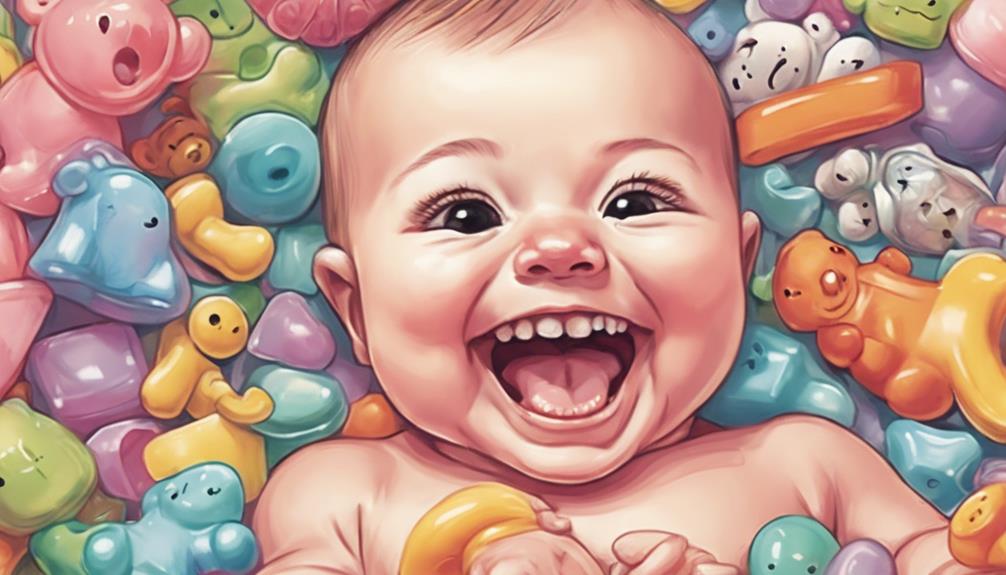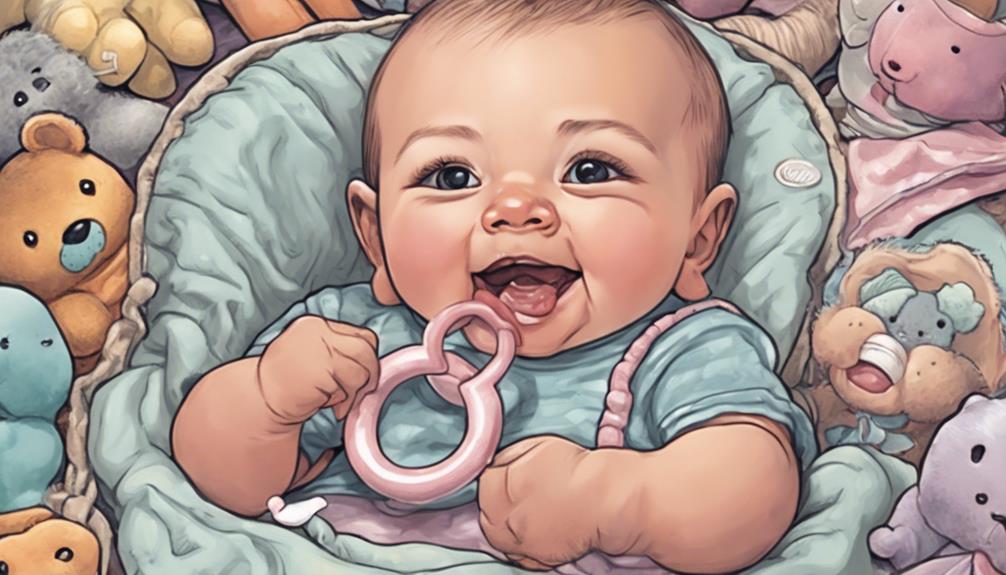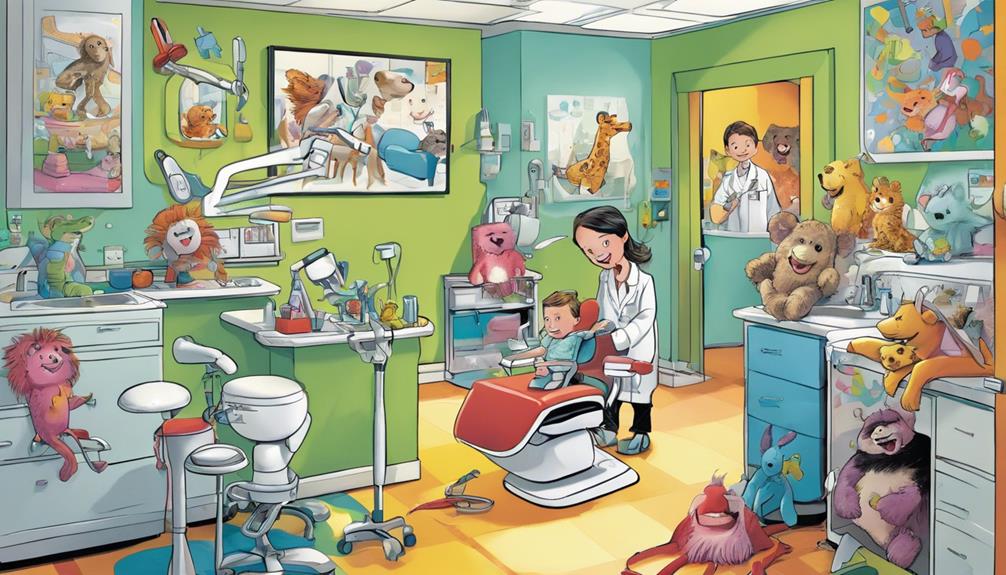Baby teeth usually start coming in around 6 months, but it can happen as early as 3 months or as late as 12 months. Typically, the first teeth to show up are the lower central incisors, followed by the upper incisors about 4 to 8 weeks later. By the age of 3, your child should have a full set of 20 primary teeth. As the teeth emerge, watch for symptoms like increased drooling and irritability. Managing this process can make it smoother for both you and your baby, and there's plenty more to discover about teething and care.
Key Takeaways
- Teething typically starts around 6 months, though some babies may begin as early as 3 months or as late as 12 months.
- The first teeth to emerge are usually the lower central incisors, followed by the upper incisors about 4 to 8 weeks later.
- By age 3, children generally have a complete set of 20 primary teeth.
- Monitor for common teething symptoms like increased drooling, irritability, and disrupted sleep patterns.
Understanding Teething

Teething usually kicks off around 6 months, but some babies might start as early as 3 months or as late as 12 months.
You'll notice that the first teeth to emerge are typically the lower central incisors, followed by the upper incisors about 4 to 8 weeks later. This process is a natural part of your baby's development, as they work to cut through the gums.
During teething, your baby may experience discomfort, which can manifest through various teething symptoms. You'll probably see increased drooling, fussiness, and a desire to chew on objects to soothe their sore gums.
It's important to recognize that this phase is significant for your baby's overall growth, as they'll eventually have all 20 primary teeth by age 3. These primary teeth play an essential role in reserving space for permanent teeth, supporting facial structure, and aiding in nutrition and speech development.
Understanding teething helps you prepare for this challenging yet natural phase. By being aware of what to expect, you can provide comfort and support as your little one navigates the emergence of their first teeth.
Teething Timeline

Typically, your baby's teething timeline starts around 6 months, but it can vary considerably, with some infants beginning as early as 3 months or as late as 12 months. The first tooth to erupt is usually the lower central incisors, which appear between 6 to 10 months. After that, the upper central incisors typically emerge around 8 to 12 months. By age 3, your child should have their complete set of 20 primary teeth.
Here's a quick tooth eruption chart to help you understand the order of teething:
| Age Range | Teeth Erupted |
|---|---|
| 6-10 months | Lower central incisors |
| 8-12 months | Upper central incisors |
| 1-3 years | Lateral incisors, first molars, canines, second molars |
As you track your baby's teething timeline, remember that variations in onset and order can occur among different infants. Monitoring this process will help you prepare for changes in your baby's behavior as they experience teething. Make note of each milestone and enjoy this exciting phase of growth!
Signs of Teething

As your baby starts teething, you might notice some common symptoms that signal the arrival of those first teeth.
Look out for increased drooling, irritability, and a strong urge to chew on objects.
Understanding these signs can help you manage their discomfort effectively.
Common Teething Symptoms
Common signs that your baby is teething include increased drooling, a desire to chew on objects, and irritability. You might notice swollen gums and even some slight temperature elevations. However, a high fever usually indicates another health issue rather than teething pain. During this time, disrupted sleep patterns and brief crankiness can also occur, especially between 4 to 7 months of age.
Here's a quick overview of common teething symptoms:
| Symptom | Description | Action Required |
|---|---|---|
| Increased Drooling | Excess saliva production | Wipe your baby's chin often |
| Swollen Gums | Tenderness in the gum area | Offer a teething ring |
| Irritability | Increased fussiness and crying | Comfort your baby |
| Loss of Appetite | Reduced interest in feeding | Monitor feeding habits |
| Disrupted Sleep | Trouble falling or staying asleep | Establish a soothing routine |
While these teething symptoms are temporary, it's crucial to monitor unusual signs. If you notice diarrhea or vomiting, consult a healthcare provider to verify everything's alright.
Managing Teething Discomfort
Recognizing the signs of teething is the first step in effectively managing your baby's discomfort during this challenging time. Common signs of teething include increased drooling, swollen and tender gums, and a strong desire for chewing on objects. Your baby might also show irritability and fussiness due to teething discomfort, which can disrupt their sleep patterns.
You may notice a mild temperature rise, usually below 100.4°F (38°C). It's important to remember that this isn't a true fever, which would indicate another health issue. Additionally, loss of appetite and increased chewing on fingers or toys can signal that your baby is seeking relief from gum soreness.
To help soothe your baby's discomfort, consider using teething gels that are specifically designed for infants. A soft-bristled toothbrush can also be beneficial, allowing you to gently massage those tender gums.
Always keep an eye on your baby's symptoms, as teething experiences can vary greatly. By recognizing these signs of teething, you can take the necessary steps to provide your baby with comfort and support during this time.
Soothing Teething Discomfort

When your baby starts teething, you'll want to find ways to ease their discomfort.
Gently rubbing their gums, offering chilled teething items, and providing safe chewable options can make a big difference.
Let's explore these effective methods for soothing teething pain.
Gentle Gum Rubbing
Gently rubbing your baby's gums with a clean finger can provide soothing relief from teething discomfort. As those little teeth start to emerge, the pressure can cause irritability and fussiness in babies. By applying light pressure while rubbing the gums, you help counteract this discomfort and may even stimulate blood circulation, which can further alleviate their distress.
You can perform this gentle gum rubbing multiple times a day, especially when your baby seems particularly uncomfortable. Always remember to wash your hands thoroughly before you start to maintain hygiene and avoid any potential infections. This simple technique is a great way to soothe your little one during this challenging phase.
Rubbing your baby's gums can work well alongside other soothing methods, such as offering cold teething rings or cool washcloths. These additional options can enhance the relief during teething, providing your baby with the comfort they need.
Cold Teething Items
Using cold teething items can effectively soothe your baby's discomfort by numbing their gums and reducing inflammation during the teething process. When babies start teething, they often experience swollen and tender gums, and cold items can provide much-needed relief.
Here are some great options to take into account:
- Teething Rings: Choose solid rubber rings that can be chilled in the refrigerator. Avoid liquid-filled options to prevent leaks and choking hazards.
- Frozen Washcloths: Dampen a washcloth and freeze it for an easy-to-hold, soothing item that's gentle on sore gums.
- Cold Fruits: Supervised, chilled pieces of fruits like bananas or apples can help soothe teething discomfort while offering nutrition.
Always keep an eye on your baby while they use these cold teething items.
Consulting with your pediatrician can help you find the best remedies for your baby's teething discomfort, guaranteeing their safety and comfort during this challenging phase.
Safe Chewable Options
Choosing safe chewable options can greatly ease your baby's teething discomfort while guaranteeing their safety.
Solid rubber teethers are excellent choices as they're free of small parts that could pose a choking hazard. Look for teething rings made of firm materials, but avoid those filled with liquid to prevent leaks. Chilled teething rings can also provide relief, numbing sore gums effectively.
Another great option is frozen washcloths. When offered to your baby, the cold helps soothe their gums and can make teething less uncomfortable.
Teething biscuits can be beneficial too, but keep a close eye on your little one as they munch to prevent choking. Confirm the biscuits are soft and suitable for their age.
Before introducing any new teething products, it's always wise to consult your pediatrician, especially if you have concerns about your baby's teething discomfort.
Oral Hygiene for Infants

Oral hygiene for infants starts even before their first tooth appears, as wiping their gums with a clean, damp cloth helps remove harmful bacteria and sugar. This early practice sets the stage for healthy oral habits.
Once the first tooth erupts, typically around 6 months, you should start brushing with a soft-bristled toothbrush and a small smear of fluoride toothpaste, about the size of a grain of rice.
To maintain good oral hygiene, consider these tips:
- Brush your child's teeth twice daily, ideally after breakfast and before bedtime.
- Begin flossing once two teeth touch to prevent tooth decay between them.
- Schedule regular dental check-ups by age 1 or after the first tooth emerges.
Establishing these routines early guarantees your infant's gums and teeth start off on the right track. With consistent care, you can help your child develop a strong foundation for lifelong oral health.
First Dental Visit

Scheduling your child's first dental visit around their first birthday is vital for monitoring their dental development and ensuring a healthy start. This visit typically occurs after the emergence of the first tooth, which is a significant milestone in your infant's life. Establishing a dental home by age one allows for consistent care and early detection of any potential issues.
During the first dental visit, the pediatric dentist will examine your baby's oral health, checking for signs of decay and evaluating the development of their first teeth. They may also apply fluoride varnish to help prevent cavities. This protective treatment is critical, given that your child's teeth are still developing and more susceptible to decay.
It's the perfect opportunity for you to discuss any concerns you might have about teething, oral hygiene practices, and your child's dietary habits. By addressing these topics early, you can set the foundation for a lifetime of good oral health.
Frequently Asked Questions
When Should I Expect My Baby Teeth?
You can expect your baby's teeth to start coming in around six months, though it varies. Look for signs like drooling and fussiness. The first teeth usually appear as lower central incisors.
Is It Normal for a 10 Month Old to Have No Teeth?
Don't sweat it; it's perfectly normal for your 10-month-old not to have teeth yet. Many babies experience variability in teething, so as long as they're happy and healthy, you're good to go!
What Is the Timeline of Baby Teeth Coming In?
The timeline for baby teeth typically starts around 6 months. You can expect the lower central incisors first, followed by upper incisors, with a complete set of 20 teeth usually by age 3.
How Can I Make My Baby Teeth Come Faster?
You can't rush teething, but offering chilled teething rings and gently massaging your baby's gums may help. A balanced diet rich in calcium and regular dental check-ups will support their dental health and development.
Are There Signs of Delayed Baby Teeth Coming In?
Parents may notice “when baby teeth come in” signs of delayed teething such as late appearance of teeth, gaps between teeth, or impacted teeth. It’s important to consult with a pediatric dentist if concerns arise about the timing of your child’s tooth development.
Conclusion
In summary, knowing when baby teeth come in can ease your worries and help you prepare. Teething usually starts around six months, but every child is unique. Understanding the baby teething timeline is helpful for parents in knowing what to expect as their child grows. The front teeth typically come in first, followed by the molars and canines. Some children may experience discomfort and irritability during this time, while others may show no signs of teething at all. By being aware of the baby teething timeline, parents can better support their child through this developmental stage.
Keep an eye out for signs and soothe their discomfort with gentle methods. Remember, good oral hygiene is essential, even for tiny teeth.
Don't forget to schedule that first dental visit by their first birthday. By staying informed, you'll navigate this teething journey with confidence and care.









